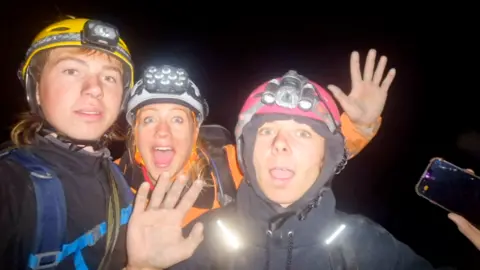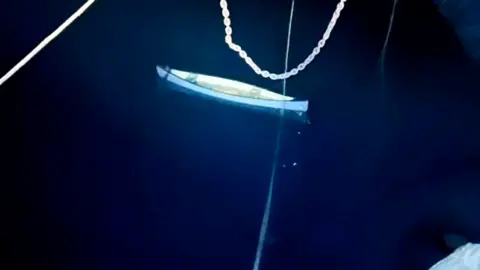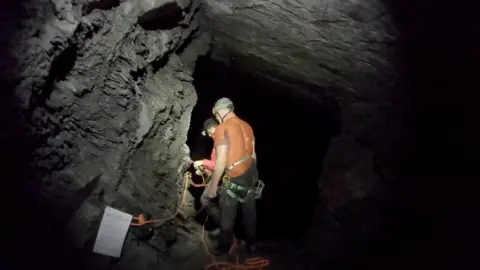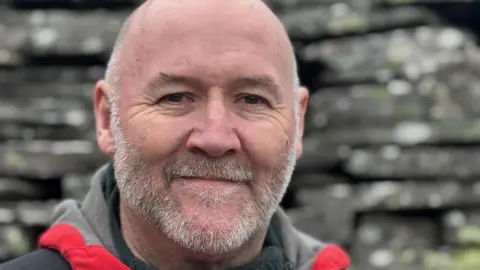 Family Photo
Family Photo“It’s the scariest thing that has ever happened to me in my life – ever.”
Josh, 15, had joined friend Draigen and his mother Kate, an experienced climber, caver and adventurer, for what was meant to be an exhilarating trip through an underground slate mine system near Blaenau Ffestiniog in Gwynedd.
But things took a turn for the worse after a canoe capsized on a freezing subterranean lake, leaving Draigen stuck, cold and wet so his mum had to leave both boys to seek help.
Mountain rescuers are urging people to ensure they plan their adventures as they brace themselves for an influx of visitors during the summer school holidays.
BBC Wales’ TV series SOS: Extreme Rescues has been following them over the last year.
But this shows that the dangers are not always on the mountains – sometimes they are beneath.
“I’ve always been interested in mountains and trying to get really good experiences with my children,” said Kate, from Essex.
“Doing something like that is really wholesome and it just builds so many skills.”
For Kate, visiting the cave system that reached down to 130m (425ft) in places, was the perfect adventure for her son and his friend.
She said she had researched the route carefully, and all three were well equipped for the trip involving rope bridges, abseiling down rock faces, using zip lines, and even a boat to cross a freezing lake.
Three hours into the route, they approached the lake, one of the mine’s biggest obstacles, which is 50m (160ft) across and reaches a depth of 60m (200ft) in places.
 Family Photo
Family Photo“There was just a rope hanging in the water, so me and Josh just started pulling this rope and there was a canoe on the end of this rope,” said Draigen.
“It was just insane.”
Kate was the first to abseil down to the canoe to cross the lake.
“I always like to make sure it’s safe.”
Josh followed but when it was Draigen’s turn – disaster struck.
“I just stood on the wrong spot,” Draigen said.
“It just sunk.”
On footage captured underground, he tells his mother he is “literally waist deep” in freezing water.
“I was panicking – I was struggling to climb back out. All the rock was crumbling off the wall,” he said.
“I was in the water for about a minute. It was freezing cold.”
He managed to pull himself on to a rock, but he was now stuck, stranded on the other side of the lake, unable to reach the path above him, and unable to get to his mother or friend.
Kate said she was worried he could suffer the cold effects of hypothermia and managed to get a survival bag over to help him.
They were deep underground, and it meant no phone signal to call for help so she had one choice – to leave the two boys and go for help herself.
“That was one of the most difficult decisions I probably have made, I would say, in my lifetime,” she said.
“I knew how scary that was going to be for them.”
 BBC Cymru Wales | Darlun
BBC Cymru Wales | DarlunIt took her two-and-a-half hours to find her way back out of the mine complex, to finally raise the alarm.
The rescue operation then swung into action, with the Aberglaslyn Mountain Rescue Team above ground, and North Wales Cave Rescue Organisation volunteers heading into the mine.
In all, it was four hours since Kate had left when rescuers found the two teens – safe but cold.
“When I heard their voices – the relief I felt,” said Draigen, who was brought to safety by the cave rescue team.
He was handed a flask of hot chocolate and some warm clothes, before he and Josh were helped out of the mine to be reunited with Kate.
Josh added: “I was so relieved – all the stress that had built up, just went.”
The first thing the boys asked was if Kate was okay.
“I was so proud of them,” she said.
It was the outcome the rescuers had hoped for, after initial fears for their safety, and whether they had left the location in an attempt to find their own way out.
“We didn’t know if they were injured,” said Dave Evans from Aberglaslyn Mountain Rescue Team.
“We were hoping that they’d stayed… but they did. They did exactly what they were meant to do.”

The mountain rescue team leader said it highlighted the importance of being prepared – and the need to plan ahead for emergencies.
Last year saw the seven north Wales rescue teams deal with more than 750 call-outs, with more than 320 in the area covering the highest peak Yr Wyddfa, also known as Snowdon, the most call-outs for any of the teams across Wales and England.
“When you come to Wales, to Eryri [also known as Snowdonia], you plan your route – you’ve planned your vehicle, how much petrol you’ve got in your vehicle to get to north Wales,” he said.
“It’s no different when you come and set foot on the mountains of north Wales.
“Things can go wrong, hopefully it doesn’t. But if you’ve planned – then half the battle is won.”

